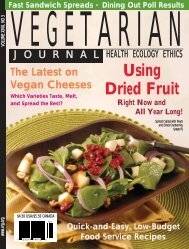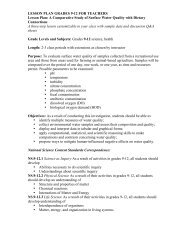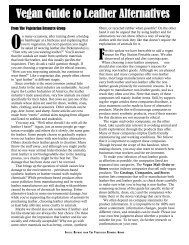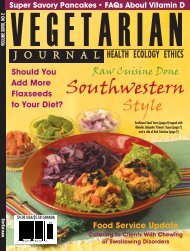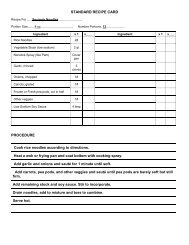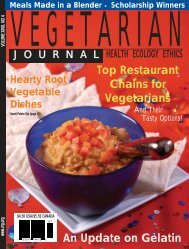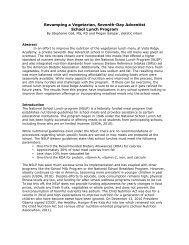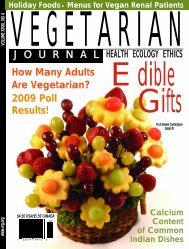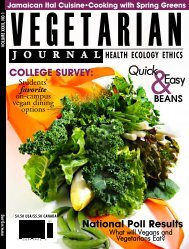Vegan Thickeners - The Vegetarian Resource Group
Vegan Thickeners - The Vegetarian Resource Group
Vegan Thickeners - The Vegetarian Resource Group
Create successful ePaper yourself
Turn your PDF publications into a flip-book with our unique Google optimized e-Paper software.
Eating a Variety of Colorful Fruits<br />
and Vegetables May Protect Against<br />
a Leading Cause of Blindness<br />
by Ben A. Shaberman<br />
THE OLD ADAGE “CARROTS ARE GOOD FOR YOUR<br />
eyes” holds a lot of truth. Carrots are rich in<br />
beta carotene, which your body converts into<br />
vitamin A—a nutrient essential to the biochemical<br />
process in your retina that enables you to see. However,<br />
experts believe your retinas might be even better off<br />
if you ate not only carrots but a wide variety of fruits<br />
and vegetables as well.<br />
Recent studies suggest that eating a diverse mix<br />
of colorful fruits and vegetables, which are good<br />
sources of antioxidants, may help protect against a<br />
vision-robbing retinal condition called age-related<br />
macular degeneration (AMD). In the United States<br />
and much of the Western world, AMD is the leading<br />
cause of legal blindness in individuals who are 55 years<br />
of age and older. Approximately 9 million Americans<br />
are affected by AMD, and that number is expected<br />
to double by 2020 because of the aging population.<br />
AMD is characterized by the build-up of drusen,<br />
yellowish deposits comprised of fats and proteins, under<br />
the central region of the retina known as the macula.<br />
<strong>The</strong> accumulation of drusen can lead to the dry form<br />
of AMD. Though dry AMD can sometimes cause<br />
vision loss, the condition puts people at increased risk<br />
for the wet form of AMD, which more frequently<br />
leads to rapid and severe loss of central vision. In wet<br />
AMD, unhealthy, leaky blood vessels grow under the<br />
macula, causing it to degenerate. Most current treatments<br />
for wet AMD involve injections into the eye<br />
to halt unhealthy blood vessel growth. <strong>The</strong>re is no<br />
known cure for either form of AMD.<br />
In an investigation called “A Dietary Antioxidant<br />
Index and Risk for Advanced Age-Related Macular<br />
Degeneration in the Age-Related Eye Disease Study”<br />
conducted by the National Eye Institute, researchers<br />
evaluated the antioxidant intake of more than 1,700<br />
individuals who were between 60 and 80 years of age.<br />
Study subjects completed food frequency questionnaires<br />
and were assigned a value on an antioxidant<br />
index scale, based on the volume and diversity of<br />
their antioxidant intake. Subsequently, subjects were<br />
placed in one of five quintiles according to the value<br />
of their antioxidant index. Those individuals in the<br />
fifth quintile (those with highest antioxidant indexes)<br />
were approximately 40 percent less likely to have wet<br />
AMD, an advanced form of the disease, than people<br />
in the first quintile (those with lowest antioxidant<br />
indexes). <strong>The</strong> antioxidant nutrients that comprised<br />
LEFT: A scene viewed with normal vision. RIGHT: <strong>The</strong> same scene as it might be viewed by a person with age-related macular degeneration.<br />
Photos courtesy of the National Eye Institute, National Institutes of Health<br />
10 Issue One 2007 VEGETARIAN JOURNAL



